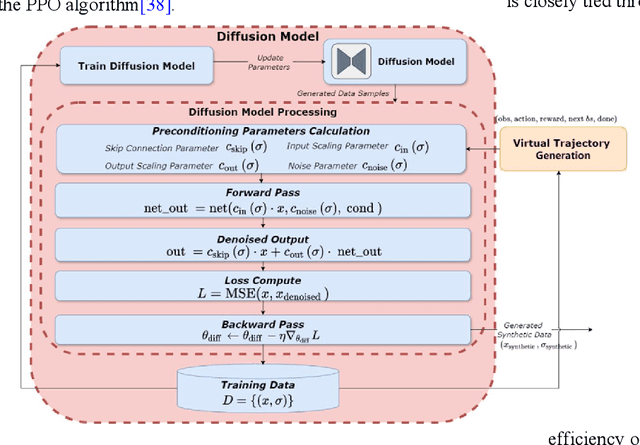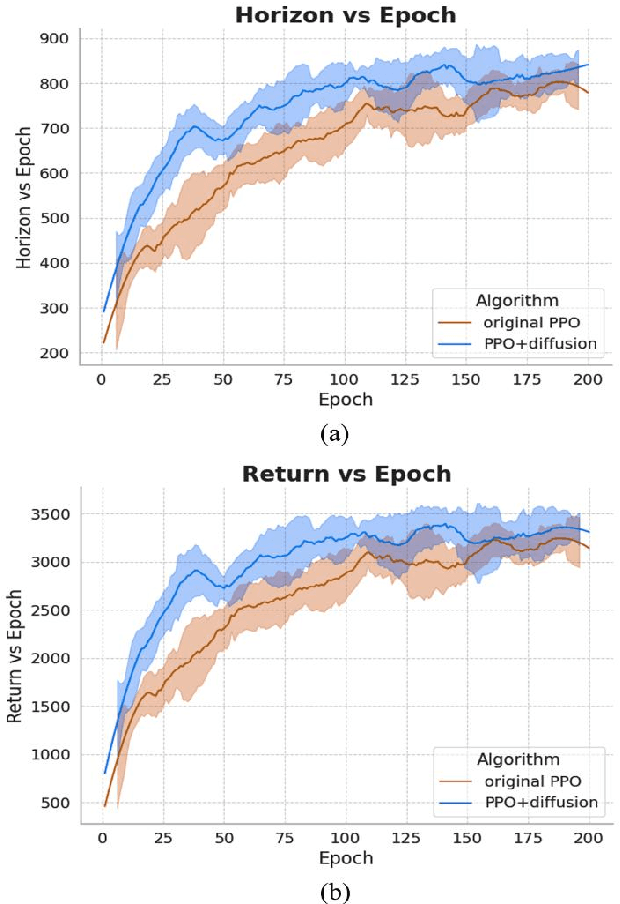Yang Bo
Enhancing Sample Efficiency and Exploration in Reinforcement Learning through the Integration of Diffusion Models and Proximal Policy Optimization
Sep 02, 2024



Abstract:Recent advancements in reinforcement learning (RL) have been fueled by large-scale data and deep neural networks, particularly for high-dimensional and complex tasks. Online RL methods like Proximal Policy Optimization (PPO) are effective in dynamic scenarios but require substantial real-time data, posing challenges in resource-constrained or slow simulation environments. Offline RL addresses this by pre-learning policies from large datasets, though its success depends on the quality and diversity of the data. This work proposes a framework that enhances PPO algorithms by incorporating a diffusion model to generate high-quality virtual trajectories for offline datasets. This approach improves exploration and sample efficiency, leading to significant gains in cumulative rewards, convergence speed, and strategy stability in complex tasks. Our contributions are threefold: we explore the potential of diffusion models in RL, particularly for offline datasets, extend the application of online RL to offline environments, and experimentally validate the performance improvements of PPO with diffusion models. These findings provide new insights and methods for applying RL to high-dimensional, complex tasks. Finally, we open-source our code at https://github.com/TianciGao/DiffPPO
Confidence Adaptive Regularization for Deep Learning with Noisy Labels
Sep 05, 2021



Abstract:Recent studies on the memorization effects of deep neural networks on noisy labels show that the networks first fit the correctly-labeled training samples before memorizing the mislabeled samples. Motivated by this early-learning phenomenon, we propose a novel method to prevent memorization of the mislabeled samples. Unlike the existing approaches which use the model output to identify or ignore the mislabeled samples, we introduce an indicator branch to the original model and enable the model to produce a confidence value for each sample. The confidence values are incorporated in our loss function which is learned to assign large confidence values to correctly-labeled samples and small confidence values to mislabeled samples. We also propose an auxiliary regularization term to further improve the robustness of the model. To improve the performance, we gradually correct the noisy labels with a well-designed target estimation strategy. We provide the theoretical analysis and conduct the experiments on synthetic and real-world datasets, demonstrating that our approach achieves comparable results to the state-of-the-art methods.
Co-matching: Combating Noisy Labels by Augmentation Anchoring
Mar 23, 2021



Abstract:Deep learning with noisy labels is challenging as deep neural networks have the high capacity to memorize the noisy labels. In this paper, we propose a learning algorithm called Co-matching, which balances the consistency and divergence between two networks by augmentation anchoring. Specifically, we have one network generate anchoring label from its prediction on a weakly-augmented image. Meanwhile, we force its peer network, taking the strongly-augmented version of the same image as input, to generate prediction close to the anchoring label. We then update two networks simultaneously by selecting small-loss instances to minimize both unsupervised matching loss (i.e., measure the consistency of the two networks) and supervised classification loss (i.e. measure the classification performance). Besides, the unsupervised matching loss makes our method not heavily rely on noisy labels, which prevents memorization of noisy labels. Experiments on three benchmark datasets demonstrate that Co-matching achieves results comparable to the state-of-the-art methods.
CLTA: Contents and Length-based Temporal Attention for Few-shot Action Recognition
Mar 18, 2021



Abstract:Few-shot action recognition has attracted increasing attention due to the difficulty in acquiring the properly labelled training samples. Current works have shown that preserving spatial information and comparing video descriptors are crucial for few-shot action recognition. However, the importance of preserving temporal information is not well discussed. In this paper, we propose a Contents and Length-based Temporal Attention (CLTA) model, which learns customized temporal attention for the individual video to tackle the few-shot action recognition problem. CLTA utilizes the Gaussian likelihood function as the template to generate temporal attention and trains the learning matrices to study the mean and standard deviation based on both frame contents and length. We show that even a not fine-tuned backbone with an ordinary softmax classifier can still achieve similar or better results compared to the state-of-the-art few-shot action recognition with precisely captured temporal attention.
 Add to Chrome
Add to Chrome Add to Firefox
Add to Firefox Add to Edge
Add to Edge